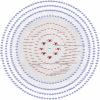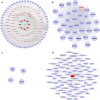Molecular targets of Yangyin Fuzheng Jiedu Prescription in the treatment of hepatocellular carcinoma based on network pharmacology analysis
- PMID: 33292207
- PMCID: PMC7650191
- DOI: 10.1186/s12935-020-01596-y
Molecular targets of Yangyin Fuzheng Jiedu Prescription in the treatment of hepatocellular carcinoma based on network pharmacology analysis
Abstract
Background: Yangyin Fuzheng Jiedu Prescription (YFJP) is a traditional Chinese medicine (TCM) indicated for the treatment of hepatocellular carcinoma (HCC). Its potential targets and molecular mechanisms are not clear. Therefore, this study intends to explore the molecular mechanism of YFJP based on network pharmacology analysis and in vitro validation.
Methods and results: Through univariate and multivariate analyses and survival analysis in HCC patients with or without YFJP treatment we found that drinking alcohol, alfafeto protein ≥ 400 ng/l, baseline portal vein tumor thrombus and total bilirubin level ≥ 18.8 μM) were independent risk factors for poor prognosis, while red blood cell count ≥ 4 × 109/l and TCM treatment were independent protective factors. Besides, YFJP prolonged the cumulative survival of HCC patients. Using online pharmacological methods, we obtained 58 relevant compounds and molecular 53 targets. By using scratch test, Transwell assay, EdU assay, and TUNEL staining, we found that YFJP-containing serum repressed the migration, invasion and proliferation of HCC cells in vitro, and induced cell apoptosis. Moreover, YFJP diminished the gene expression of TP53, CCND1, p-EGFR, EGF, VEGFA, JUN, IL6, COX-2, AKT1, and MAPK1 in HCC cells, but elevated the expression of ESR1 and CASP3.
Conclusions: Taken together, results showed that YFJP attenuated HCC progression through mediating effects on HCC-related genes.
Keywords: Apoptosis; Cumulative survival; Hepatocellular carcinoma; Invasion; Migration; Network pharmacology; Proliferation; Yangyin fuzheng jiedu prescription.
Conflict of interest statement
The authors declare no competing interests.
Figures








Similar articles
-
FoxO1 as a Hub in Immunosenescence Induced by Hepatocellular Carcinoma and the Effect of Yangyin Fuzheng Jiedu Prescription.Drug Des Devel Ther. 2025 Mar 5;19:1543-1560. doi: 10.2147/DDDT.S492576. eCollection 2025. Drug Des Devel Ther. 2025. PMID: 40061815 Free PMC article.
-
Mechanisms and network pharmacological analysis of Yangyin Fuzheng Jiedu prescription in the treatment of hepatocellular carcinoma.Cancer Med. 2023 Feb;12(3):3237-3259. doi: 10.1002/cam4.5064. Epub 2022 Aug 31. Cancer Med. 2023. PMID: 36043445 Free PMC article.
-
Yangyin Fuzheng Jiedu Prescription exerts anti-tumor immunity in hepatocellular carcinoma by alleviating exhausted T cells.Phytomedicine. 2021 Oct;91:153722. doi: 10.1016/j.phymed.2021.153722. Epub 2021 Aug 19. Phytomedicine. 2021. PMID: 34488188
-
Integrating Network Pharmacology and Experimental Models to Investigate the Efficacy of Coptidis and Scutellaria Containing Huanglian Jiedu Decoction on Hepatocellular Carcinoma.Am J Chin Med. 2020;48(1):161-182. doi: 10.1142/S0192415X20500093. Epub 2020 Jan 21. Am J Chin Med. 2020. PMID: 31964157
-
Chinese herbal medicine-derived compounds for cancer therapy: a focus on hepatocellular carcinoma.J Ethnopharmacol. 2013 Oct 7;149(3):601-12. doi: 10.1016/j.jep.2013.07.030. Epub 2013 Aug 1. J Ethnopharmacol. 2013. PMID: 23916858 Review.
Cited by
-
Comprehensive nursing care on the psychological states, quality of life, and serum indexes of NSCLC patients with TCM combined with chemotherapy.Am J Transl Res. 2021 Jul 15;13(7):8458-8464. eCollection 2021. Am J Transl Res. 2021. PMID: 34377343 Free PMC article.
-
Effect of modulating the extracellular matrix cross linkage by genipin on tumor cell resistance and survival in thioacetamide-induced hepatocellular carcinoma in rats.PeerJ. 2025 Jul 9;13:e19680. doi: 10.7717/peerj.19680. eCollection 2025. PeerJ. 2025. PMID: 40656954 Free PMC article.
-
FoxO1 as a Hub in Immunosenescence Induced by Hepatocellular Carcinoma and the Effect of Yangyin Fuzheng Jiedu Prescription.Drug Des Devel Ther. 2025 Mar 5;19:1543-1560. doi: 10.2147/DDDT.S492576. eCollection 2025. Drug Des Devel Ther. 2025. PMID: 40061815 Free PMC article.
-
Jiedu Fuzheng decoction improves the proliferation, migration, invasion and EMT of non-small cell lung cancer via the Wnt/β-catenin pathway.Cell Div. 2023 Dec 16;18(1):22. doi: 10.1186/s13008-023-00105-7. Cell Div. 2023. PMID: 38104091 Free PMC article.
-
Mechanism of Fuzheng Qudu prescription in the treatment of lung cancer based on network pharmacology and experimental validation.Heliyon. 2024 Sep 6;10(18):e37546. doi: 10.1016/j.heliyon.2024.e37546. eCollection 2024 Sep 30. Heliyon. 2024. PMID: 39309919 Free PMC article.
References
Grants and funding
LinkOut - more resources
Full Text Sources
Research Materials
Miscellaneous

